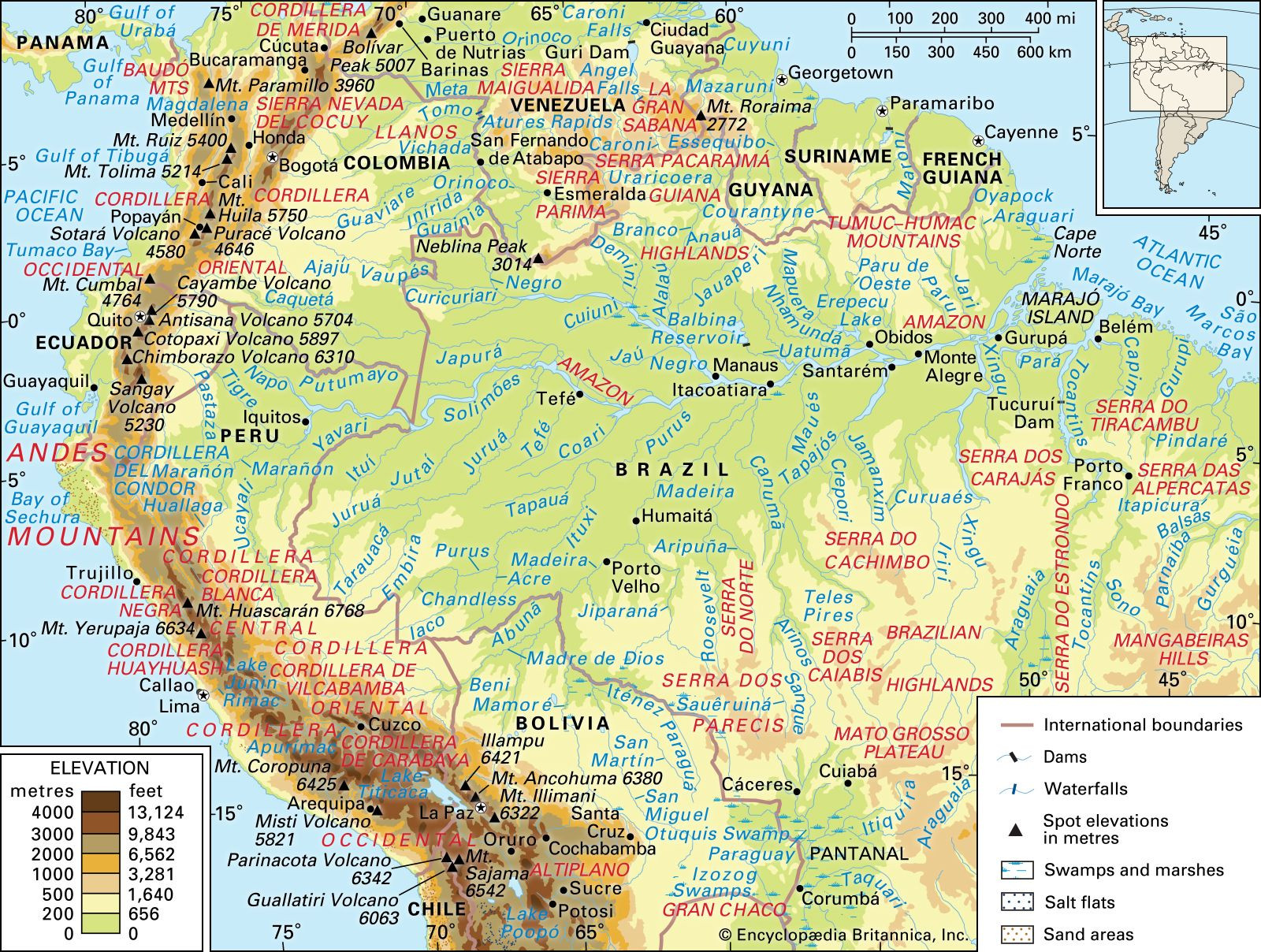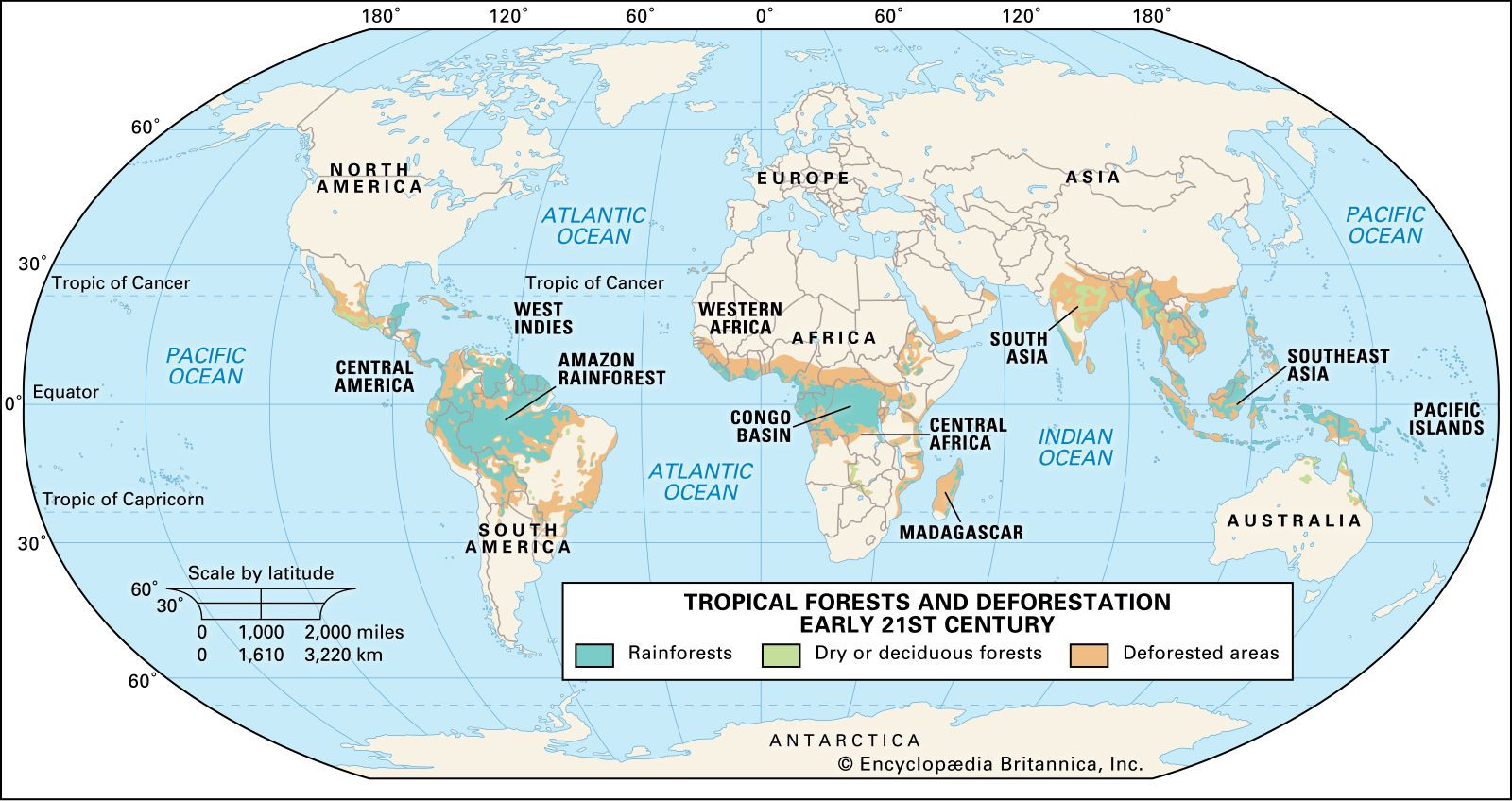The Amazon Rainforest, a name synonymous with biodiversity and natural wonder, is Earth’s most expansive tropical rainforest. But where is the Amazon Rainforest exactly? This vital ecosystem dominates a significant portion of northern South America, sprawling across nine countries and encompassing the massive Amazon River basin. Let’s delve into the geographical heart of this irreplaceable treasure and understand its precise location and immense scale.
The Amazon Rainforest is primarily situated in Brazil, which contains approximately 60% of its total area. However, its reach extends into eight other nations: Peru, Colombia, Venezuela, Ecuador, Bolivia, Guyana, Suriname, and French Guiana. This vast forest is geographically defined by the Amazon River basin, the largest drainage basin in the world, fed by the mighty Amazon River and its countless tributaries.
 Central and Northern Andes and the Amazon River basin and drainage network
Central and Northern Andes and the Amazon River basin and drainage network
The Amazon rainforest location is intricately linked to the Amazon River basin and drainage network.
The Amazon’s boundaries are naturally defined by significant geographical features. To the north, the Guiana Highlands mark its limit, while the Andes Mountains, the world’s longest continental mountain range, form its western edge. In the south, the Brazilian central plateau provides a natural demarcation, and to the east, the Amazon stretches towards the Atlantic Ocean. From the Atlantic coast inland to the Andean foothills, the rainforest expands dramatically, starting as a 200-mile front at the Atlantic and widening to an impressive 1,200-mile belt where the lowlands meet the Andes.
The sheer size and unbroken expanse of the Amazon Rainforest are directly attributable to the region’s consistent climate. High rainfall, consistently high humidity, and uniformly high temperatures are the prevailing conditions throughout the Amazon basin. This tropical climate fosters the dense, lush vegetation that characterizes this unique biome.
The vital role of rainforests in the global ecosystem and climate regulation.
The Amazon Rainforest is globally recognized as the planet’s most biologically diverse reservoir. It teems with millions of species of insects, plants, birds, and countless other life forms, many of which remain undiscovered by science. This incredible biodiversity is supported by a rich tapestry of vegetation, including a wide array of trees such as myrtle, laurel, palm, and acacia, alongside economically important species like rosewood, Brazil nut, and rubber trees. The forest also yields valuable timber resources like mahogany and Amazonian cedar. The wildlife is equally diverse and iconic, featuring jaguars, manatees, tapirs, red deer, capybaras, numerous rodent species, and a variety of monkey species.
An overview of the diverse wildlife inhabiting the Amazon Rainforest, showcasing monkeys and other animals.
Despite its vastness and global importance, the Amazon Rainforest faces increasing threats, primarily from deforestation. In the 20th and 21st centuries, driven by Brazil’s growing population, large areas of the Amazon have been settled and cleared. This deforestation is largely due to logging for timber and conversion of forest land into grazing pastures and farmland. Brazil, holding the majority of the Amazon basin, witnessed a significant reduction in its forest cover, decreasing from approximately 1,583,000 square miles in 1970 to around 1,283,000 square miles by 2016.
Deforestation patterns in the Amazon River basin caused by farming and grazing, highlighting human impact.
While the rate of deforestation has slowed since the 1980s and 90s, alarming events like the surge in fires in 2019, partly attributed to governmental encouragement of land clearing, highlight the ongoing vulnerability of the Amazon. Efforts to protect the Amazon have been initiated by the Brazilian government and international organizations since the 1990s, aiming to combat human encroachment, exploitation, and deforestation.
The rich variety of arthropods in the Amazon Rainforest, including spiders, beetles, and scorpions, illustrating biodiversity.
Ecuador, while holding a smaller portion of the Amazon, has also played a role in conservation. In 2007, Ecuador proposed an innovative plan to protect a part of its Amazon rainforest within Yasuní National Park, a highly biodiverse region. The plan involved forgoing the development of significant oil deposits under the park in exchange for international financial contributions to a UN trust fund. Although this specific plan was eventually abandoned, it underscored the global recognition of the Amazon’s importance and the complex challenges of balancing economic development with environmental preservation.
 tropical forests and deforestation
tropical forests and deforestation
A visual representation of tropical forests and deforestation in the early 21st century, showing the global impact of deforestation.
In conclusion, the Amazon Rainforest is geographically located in northern South America, primarily in Brazil but extending across eight other countries, within the Amazon River basin. It is a vast and vital ecosystem, unmatched in its biodiversity, but facing continuous pressures. Understanding where the Amazon Rainforest is provides the essential first step in appreciating its global significance and the urgent need for its conservation.


